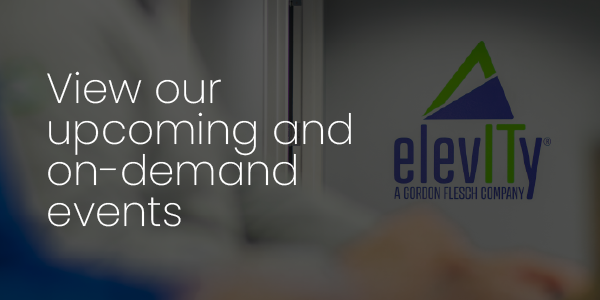Feeling a Little Lost About IT Budget Planning? You’re Not Alone.
Let’s be honest, starting your annual IT budget can feel like opening a giant jigsaw puzzle. Where do you even begin? Between cloud services, cybersecurity, infrastructure upgrades and planning for the future—the options (and acronyms) can pile up fast. And when buzzwords like zero trust, blockchain or generative AI start flying around, it’s easy to feel like you’re supposed to know more than you do.
But there’s good news. You don’t have to figure it all out at once, and you definitely don’t have to do it alone.
Whether you’re a seasoned pro or just dipping your toes into technology budgeting, this guide is here to help you take a deep breath and get organized. We’ll walk through how to align your IT budget with your organization’s goals, how to talk about technology spending in a way your finance team will appreciate, and how to make smart, strategic choices that support your team now and in the future.
Let’s start with the basics—and build from there:
- Getting Started with Technology Budgeting
- Research Your IT Budget Planning Needs
- Winning the Budgeting Game
- Making Your IT Budget Work for You
First things first. We’ll be starting with a closer look at what goes into building a thoughtful, flexible IT budget.
Getting Started with Technology Budgeting
Let’s talk about timing. These days, IT budget planning isn’t just a once-a-year scramble—it’s more like a rolling conversation. If your fiscal year wraps up in December, now’s the time to start reviewing what worked, what didn’t, and what’s changed since last year. That way, your technology investments stay aligned with your organization’s evolving goals.
And speaking of change, this year has brought its own set of challenges. While hybrid work is now commonplace, many teams are grappling with how to manage sprawling technology ecosystems, rising cybersecurity threats, and the pressure to do more with less. There’s also a growing need to support AI-driven tools, streamline data governance, and ensure that technology investments actually help people work smarter—not just add complexity.
To make smart decisions, it helps to speak the language of your finance team. That means framing IT spending in terms of business impact. Department-specific tools like CRM platforms or accounting software are usually easy to justify. But what about company-wide solutions like collaboration platforms or customer-facing technology?
This is where cross-functional conversations come in. Sit down with department heads, managers, and even your CEO or CFO to understand what their goals are and how technology can support them. The best IT budgets aren’t just about hardware and software, they’re about helping your entire organization run more efficiently, securely, and strategically.
Research Your IT Budget Planning Needs
Once you’ve got a general direction for your IT budget, it’s time to dig into the details. This part might not be flashy, but it’s where the real clarity starts to take shape.
Start by asking the right questions:
- What’s slowing your team down?
- Where are business users getting frustrated?
- What risks could derail your budget if left unchecked?
It’s not just about chasing the highest ROI anymore. The best technology investments are the ones that support your company’s broader goals—whether that’s improving customer experience, tightening up security, or making day-to-day operations smoother for your team.
Yes, Excel® might still be your trusty sidekick, but don’t stop there. Pull data from your financial reporting systems, ERP platforms, and inventory tools. Look at lifecycle and warranty info to spot what’s due for replacement. And don’t forget to factor in newer priorities like AI readiness, data privacy compliance, and cross-platform integration.
At Elevity, we meet with clients quarterly to review their technology roadmap and talk through budget planning. These conversations help ensure that IT decisions are grounded in real business needs—not just wish lists or gut feelings.
The more informed your planning is, the easier it’ll be to get buy-in from department leaders and build a budget that actually works.
Winning the Budgeting Game
When you're planning your IT budget, you’ll still want to think about cost, scope, and timeline. But there’s another piece that often gets overlooked—momentum. Not just the momentum of a project, but the energy behind it. Is your team excited about the solution? Is leadership on board? Do you have the time and resources to make it successful?
In today’s workplace, IT touches nearly every department. That means your budget isn’t just about what the IT team needs—it’s about what the whole organization needs. From marketing to HR to customer service, everyone has a stake in how technology is used. That’s why Elevity project managers work closely with client departments and executives from the very beginning. The more collaboration, the better the outcome.
It’s also important to think about what happens if you don’t invest in certain technologies. Cyber threats like phishing and ransomware are on the rise and if your organization hasn’t experienced an attack, it can be tough to justify spending on cybersecurity. But being proactive is always more cost-effective than reacting after something goes wrong.
And remember, your IT budget should be flexible enough to adjust as your business evolves. Whether you're scaling up AI tools, responding to new regulations, or shifting priorities—your budget should be ready to adapt.
Making Your IT Budget Work for You
IT budget planning doesn’t have to be intimidating. With a little structure, some honest conversations, and the right data, you can build a budget that not only supports your technology needs but also drives real business value. Whether you're navigating new tools, tightening up security, or just trying to make smarter decisions, the key is to stay flexible and keep your goals front and center.
And if you're wondering where to begin, we’ve got a helpful resource to get you started. Our Business Technology Inventory Checklist is designed to help you take stock of what you have, what you need, and what might be ready for an upgrade. Download the checklist and you’ll be on your way to start building a smarter, more strategic IT budget.
















